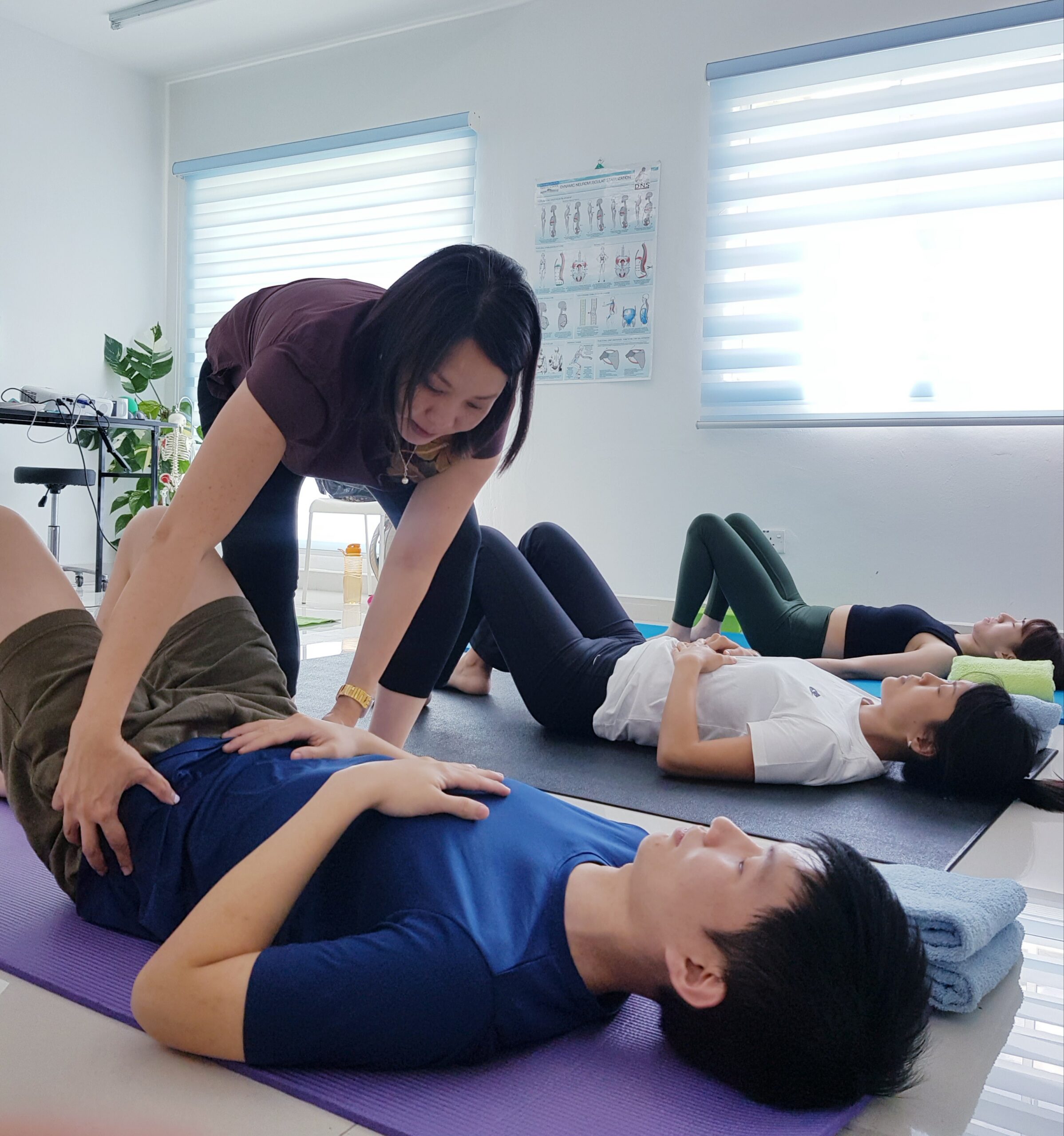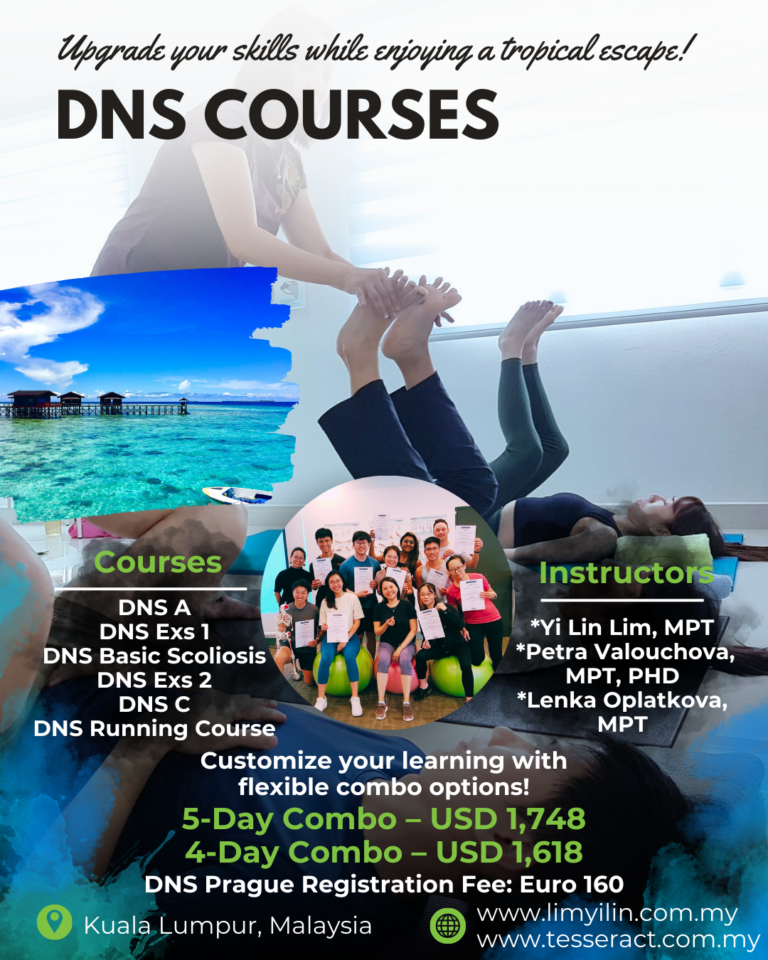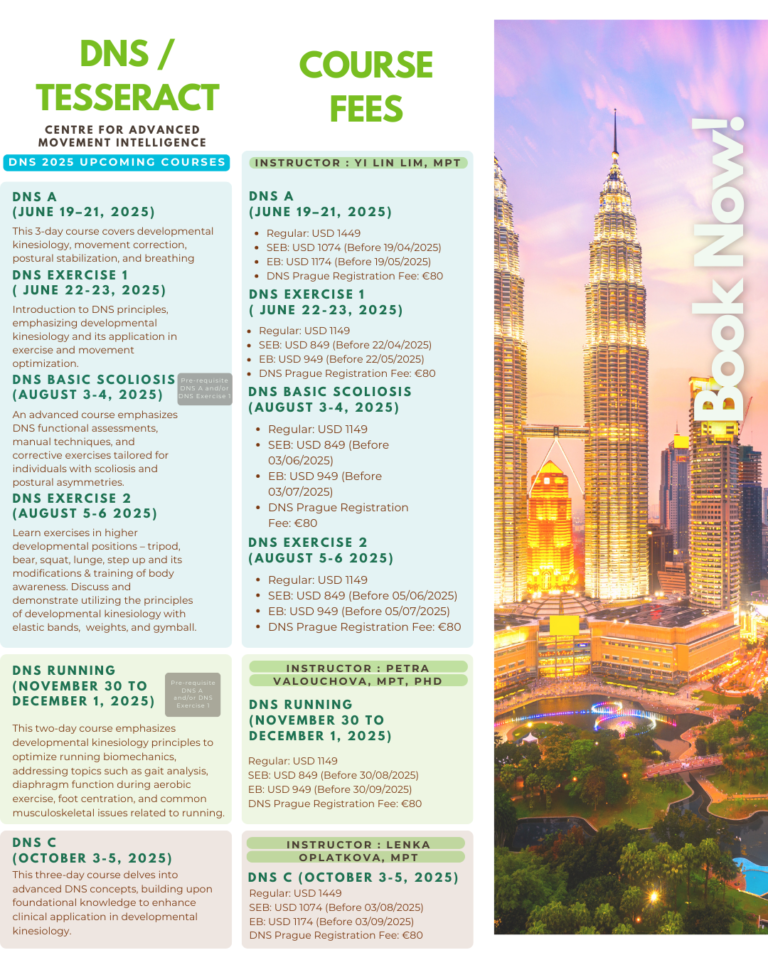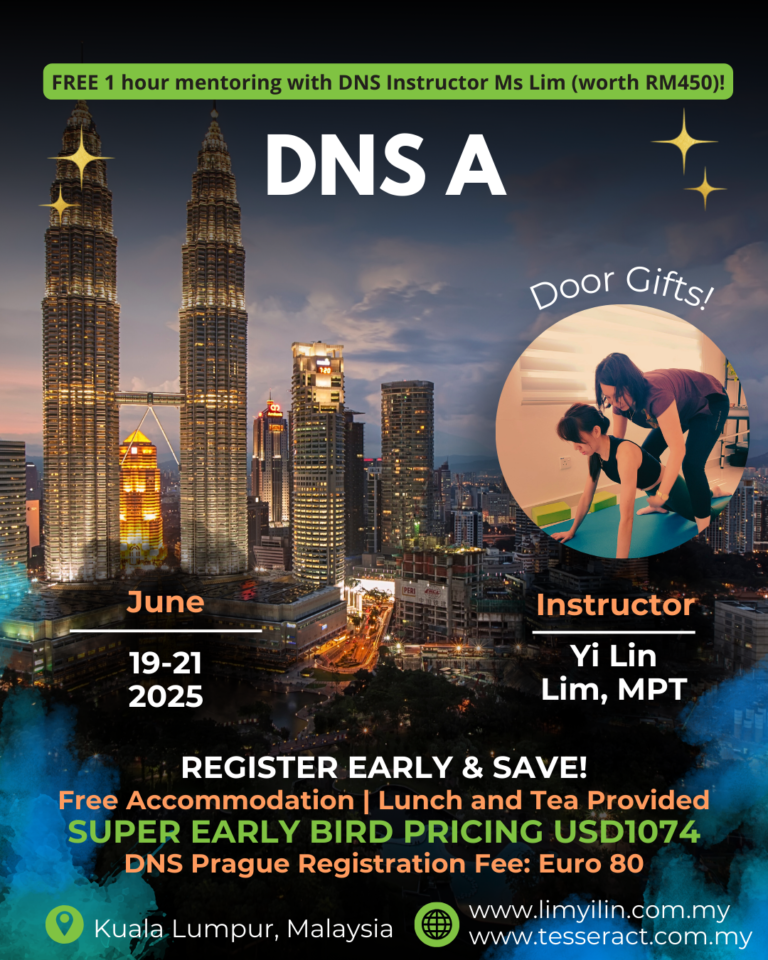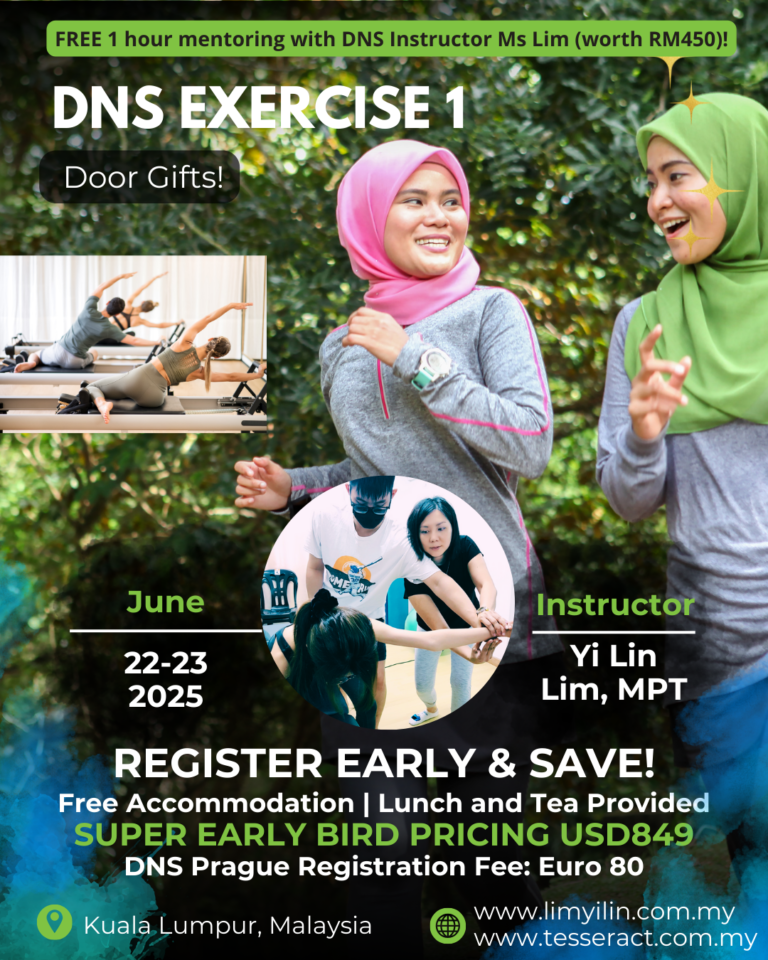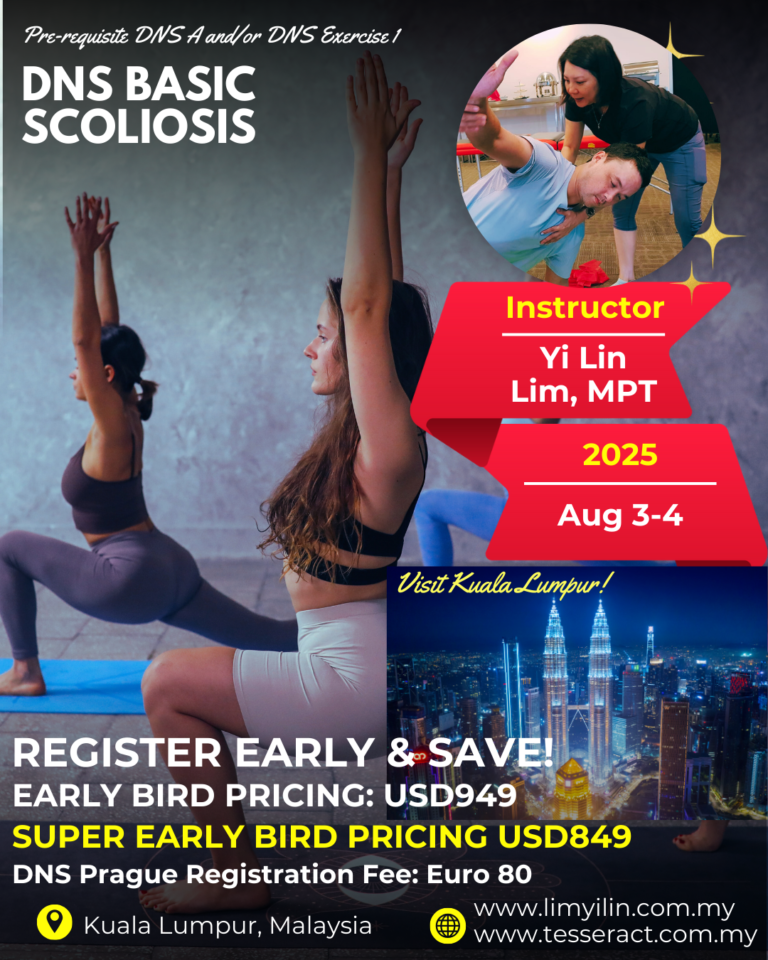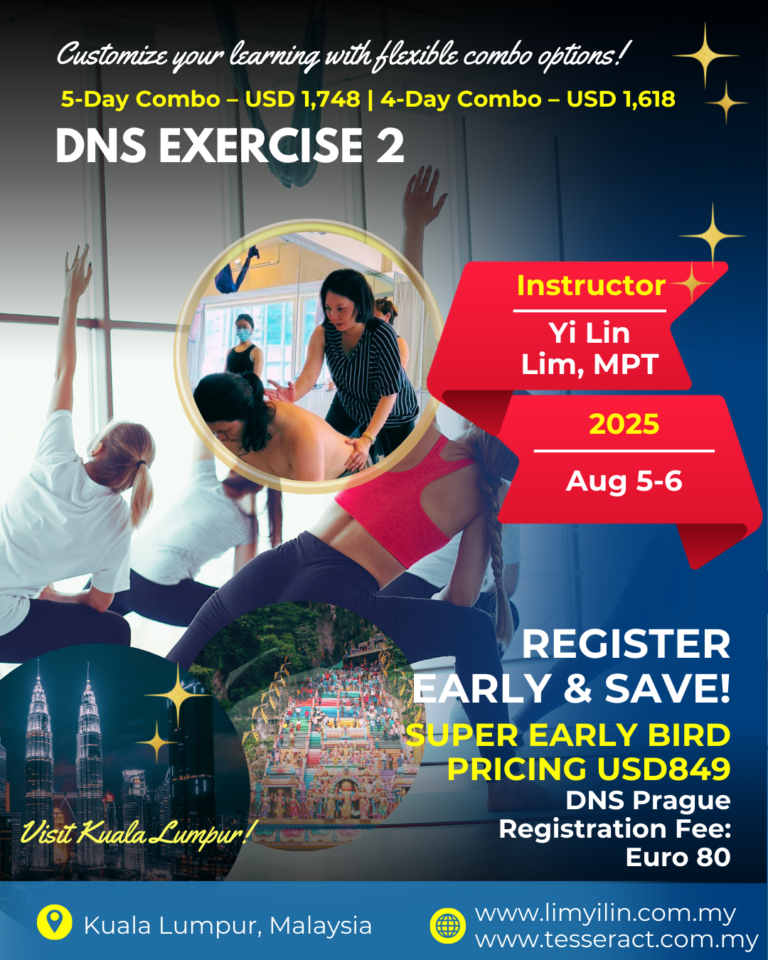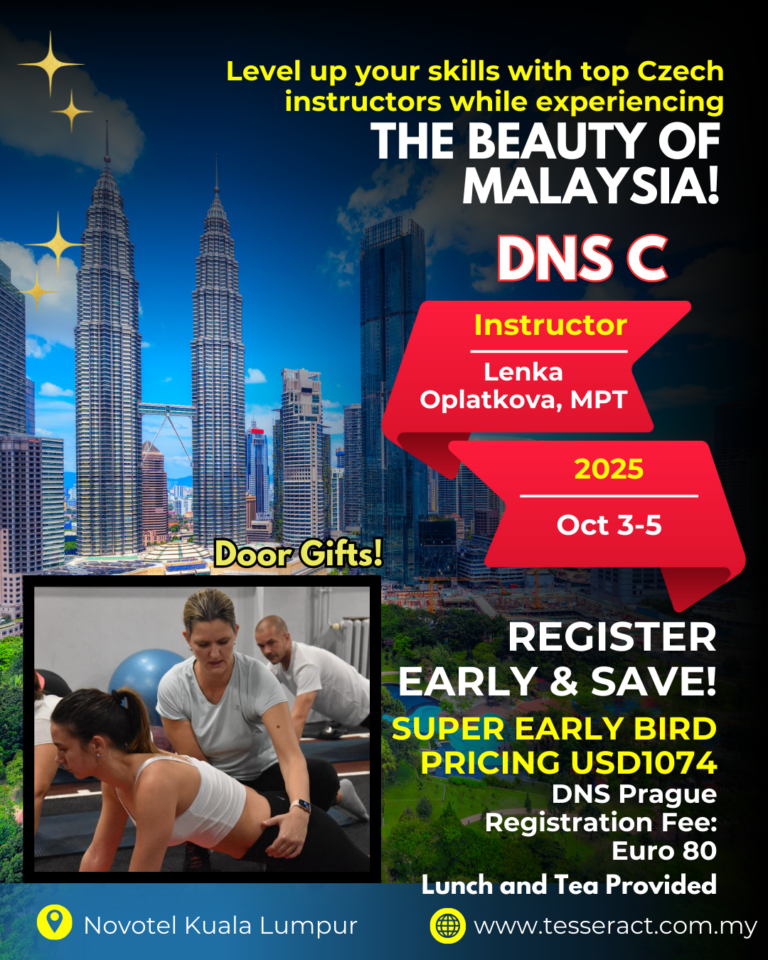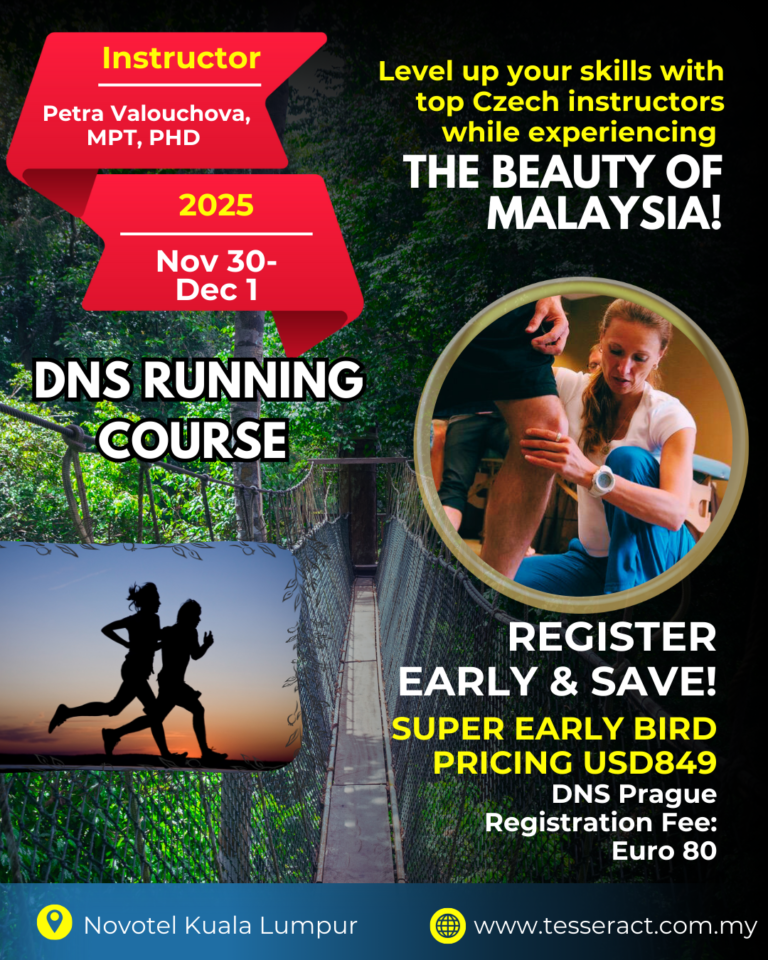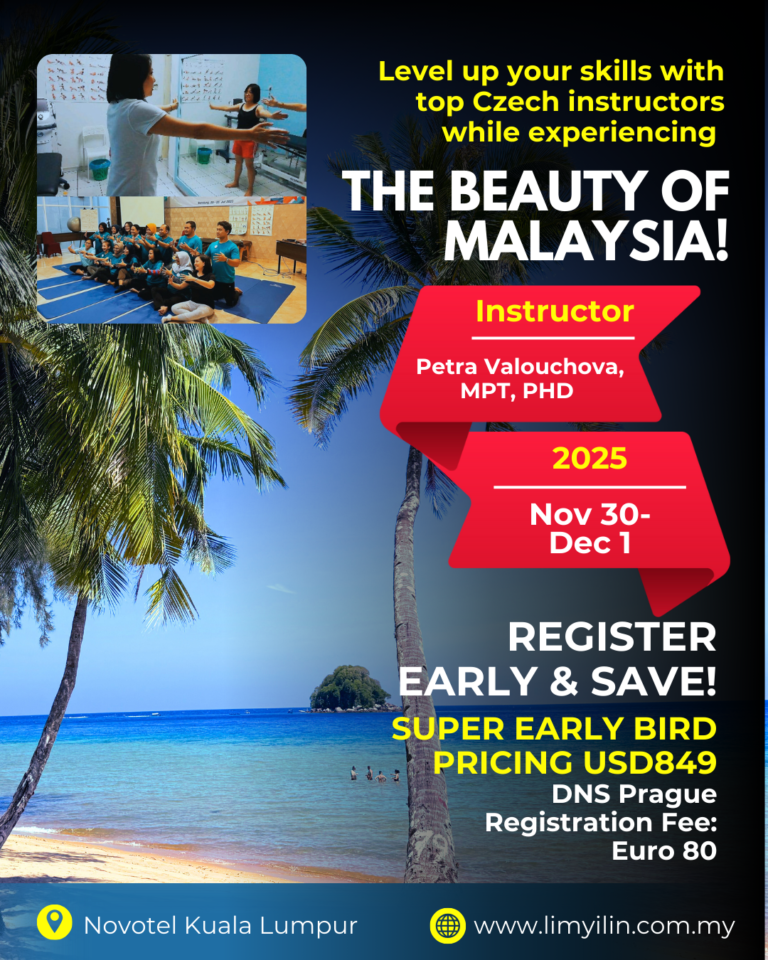Dynamic Neuromuscular Stabilisation (DNS)
I would like to warmly welcome you to Tesseract’s Dynamic Neuromuscular Stabilisation (DNS) series of workshops. It is a pleasure and privilege to be able to host you in this exciting learning journey of DNS together.
My team and I have been using the DNS strategy since 2010 in our approaches to movement care and performance with amazing results! I am confident you and your patients will benefit greatly when you implement the DNS as a strategy and not merely as another technique.
The DNS full certification process consists of 4 modules (A, B, C & D) and has been designed carefully to ensure the certified practitioner is able to make the paradigm shift from a bias towards a Structural approach to a more Balanced Functional approach in patient care. The DNS instructors you will meet are very experienced both in their clinical and training abilities. I would highly recommend you to take the DNS exams accordingly, as it truly sharpens your understanding of this new approach and allows you an opportunity to be an internationally recognised DNS Practitioner. Please read more on the requirements for attaining the full DNS Certificate on their website at www.rehabps.com. The objectives of DNS A-D for medical professionals can be found here.
There will also be DNS Special Skill courses organised by Tesseract Centre.
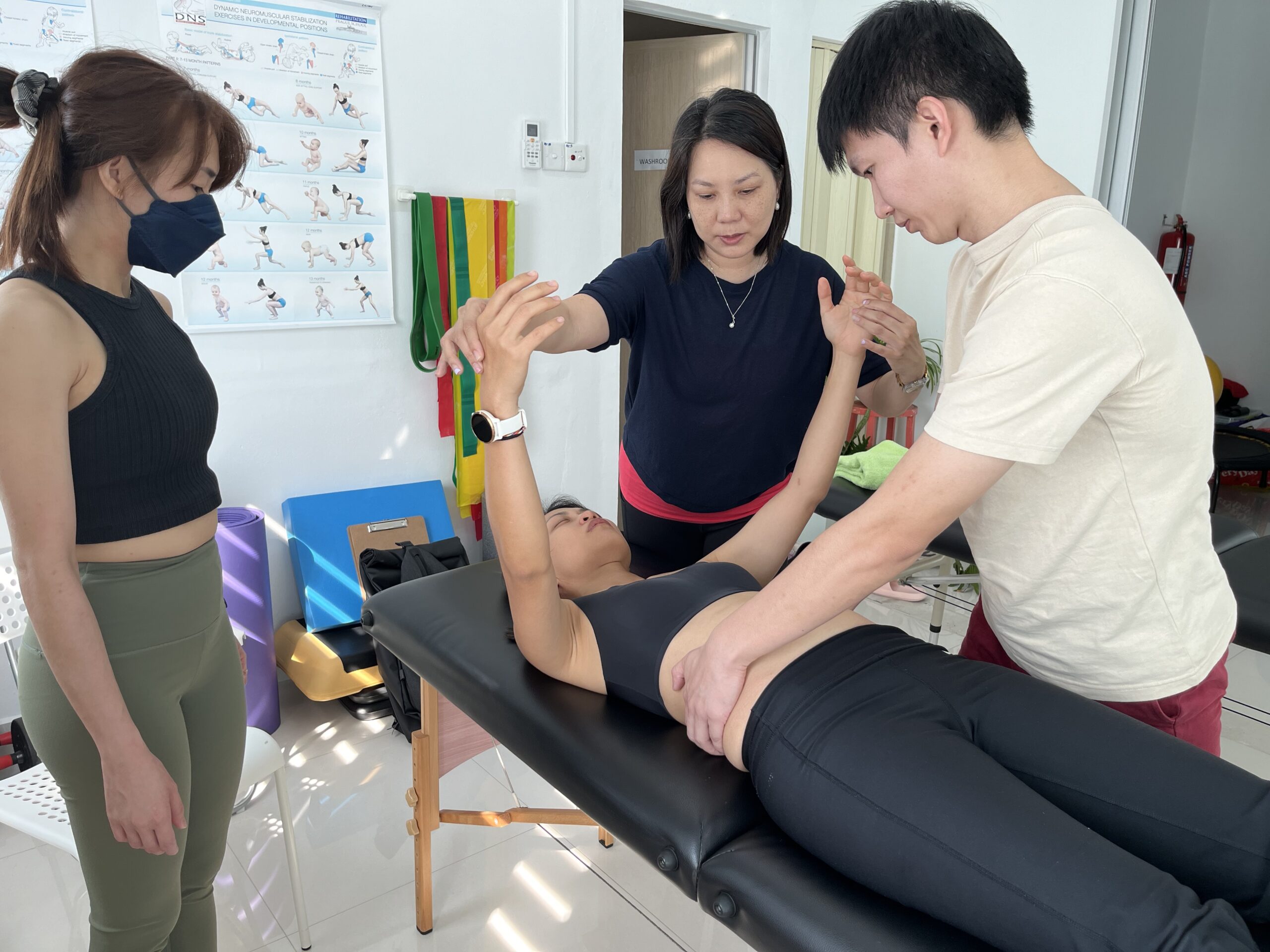
What is DNS?
DNS is an approach that believes the human locomotor (movement) system is based on the scientific principles of Developmental Kinesiology (DK). DK is the scientific understanding/guideline of how a normal baby matures in the neurophysiological aspect of our locomotor system. To put it in a nutshell, DK is a tool/guide used in DNS to compare an individual’s (at any age) stabilising/movement pattern with the stabilisation/movement developmental pattern of a healthy baby for assessment and treatment. DNS emphasises that one cannot move healthily if one cannot stabilise well the segments of the body in the overall posture adopted.
The DNS approach demonstrates that a functional joint centration can only occur when the Integrated Spinal Stabilising System (ISSS) is activated optimally. It is believed that faulty stabilising habits can influence the skeletal formation of bones and joints in a growing child. In adulthood, a faulty ISSS can lead to enhanced degenerative changes at the bones and joints. It can also lead to wear & tear syndromes of the muscles, tendons, ligaments, and discs.
KEY Concepts in DNS
Development Kinesiology (DK)
DK explains the development of motor functions of a baby after she/he is born. It sees the outcome of motor patterns (movement) from a baby not as a result from the process of learning but from the very fact that the Central Nervous System (neurophysiological aspect) is maturing. With this concept, it is able to identify specific motor patterns (movement) characteristic of a certain developmental age of the baby/child. This allows the opportunity to use this guideline as a reference for clinical assessment.
Functional Joint Centration (FJC)
FJC is the joint position that allows the most equally distributed load contact on the joints along a kinetic ‘muscular chain’ of a movement / stabilisation. This will create an ideal situation that allows the body to generate maximal muscle work while having a protective effect on the surrounding passive structures (eg. ligament, bone). In short, the GOAL of DNS strategies is to achieve FJC throughout the dynamic movements at any posture.
Integrated Spinal Stabilising System (ISSS)
In general, the major muscles in this system are:
- The pelvic floor
- The abdominal wall
- The diaphragm
- The serratus anterior
- The deep neck flexors
- Short intersegmental spinal muscles
In most situations, activation of these muscles during movement is automatic (subconscious) and not fully under our voluntary control. The interplay of all these major muscles references around the goal of creating a stable posture at its very core. Further to that, DNS advocates that respiration and stability are ALWAYS co-dependent. Understanding these 2 crucial facts leads to the importance of the goal of achieving good regulation of the intra-abdominal pressure (IAP).
Read more about this at http://www.rehabps.com/VIDEO/DNS_What_Is.html
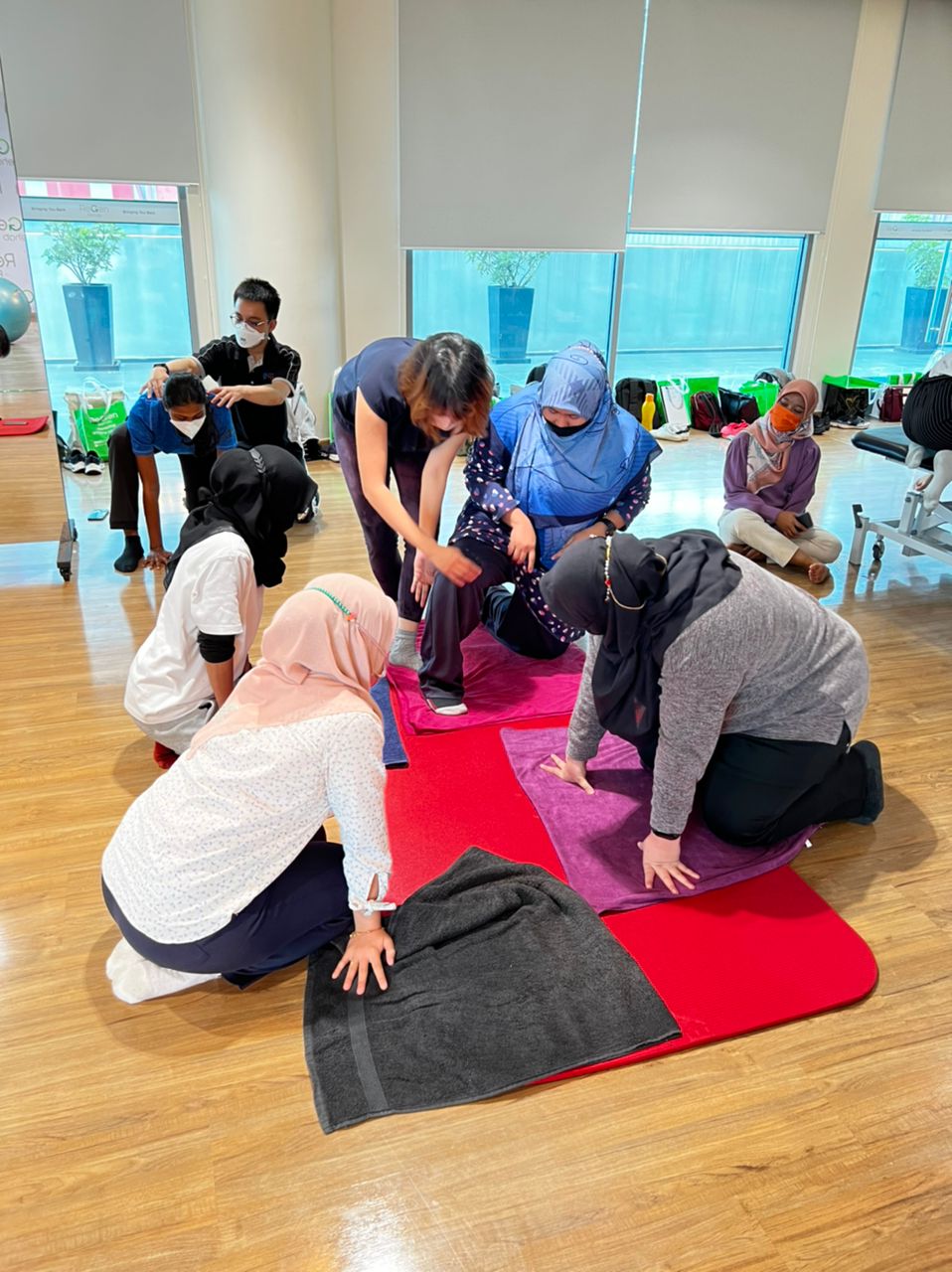
DNS Courses
Objective
- Improve understanding of the basic principles of Developmental Kinesiology with an emphasis on development during the first year of life.
- Identify and describe key milestones in human development.
- Introduce the three levels of sensorimotor control in functional assessment and treatment.
- Demonstrate the relationship between development during the first year of life and pathology of the locomotor system in adulthood.
- Introduce new terminology pertinent to rehabilitation, such as functional joint centration, punctum fixum, punctum mobile, and the integrated stabilising system of the spine.
- Define ideal postural stabilisation from a developmental perspective: intra-abdominal pressure regulation, the dual role of the diaphragm in stabilisation and respiration, and stabilisation via co-contraction.
- Identify common stereotypes of faulty postural stabilisation (“open scissors syndrome,” forward-drawn posture, backward-drawn posture, “hourglass syndrome”).
- Explain and demonstrate the biomechanics of homologous, ipsilateral, and contralateral postural-locomotion patterns; closed and opened kinematic chains; stepping forward; and supporting function.
- Evaluate and correct poor respiratory patterns.
- Demonstrate the correlation between poor respiration patterns and functional pathology of the locomotor system.
- Assess the integrated stabilising system of the spine both visually and by utilising dynamic functional tests.
- Integrate corrective exercises based on the DNS functional tests and developmental positions: exercise in homologous static positions; position transfer during locomotor function; exercise progression using unstable surfaces; increased difficulty of the exercises utilising resistance, dual tasking, and other challenges.
- Clarify how DNS corrective exercises can integrate with other exercise strategies.
- Cover the basics of the application of the DNS concept in sport training.
- Provide a basic clinical management explanation for clinicians to better integrate the DNS approach in their regular practice, including patient education.
- Optimally prepare students for the next level of sport training (Course “B”).
Objective
- Demonstrate an understanding of Developmental Kinesiology and its relationship with pathology of the locomotor system: review theory covered in the A course and introduce more advanced theory, namely the verticalization process.
- Describe the basis for primitive reflexes and postural reactions and their roles in Developmental Kinesiology.
- Introduce basic information about reflex locomotion according to Vojta.
- Perform demonstration of assessments of babies: attendees will be able to recognise ideal and disturbed locomotor patterns and determine the developmental age of the babies.
- Demonstrate and teach proper handling of infants.
- Demonstration application of DNS assessment and treatment in adult patients with pain and dysfunction within the locomotor system—stabilisation assessment and treatment strategy.
- Postural analysis & testing of integrated spinal stabilisation system—review of Course A tests and introduction to additional, advanced tests.
- Integration of corrective exercises based on newly taught DNS functional tests.
- Exercise in differentiated ipsilateral and contralateral static positions, position transfer during locomotor function, exercise progression using unstable surfaces, resistance against “planned movement,” dual tasking, and other challenges both in ipsilateral and contralateral patterns, transition between ipsilateral and contralateral patterns, and training of isolated segmental movement.
- Introduction to cortical functioning—body scheme, quality of relaxation, isolated segmental movements.
- Provide a more complex clinical management explanation for clinicians to better integrate more advanced DNS protocols into clinical practice.
- Optimally prepare students for the next level of training (Course “C”).
Objective
- Introduce advanced assessment methods—the integrated stabilising system, locomotor stereotypes, and respiratory stereotypes.
- Describe the kinesiology of muscle chains involved in locomotion: stepping forward and supporting function.
- Discuss and workshop assessment and treatment of the pelvic girdle and hip joint: phylogenetic and ontogenetic aspects, anatomical parameters from a developmental perspective, and the most common pathological conditions—femoroacetabular impingement syndrome, arthritis, DNS assessment, and treatment procedures.
- Discuss and workshop assessment and treatment of the shoulder girdle: phylogenetic and ontogenetic aspects, anatomical parameters from a developmental perspective, DNS assessment, and treatment in shoulder girdle disorders—hemiplegic shoulder, frozen shoulder, impingement syndrome, SLAP lesion.
- Discuss and workshop assessment and treatment of scoliosis: definition and classification, ontogenetic aspects leading to scoliotic development, risk factors, spine control in motor development, assessment of infants and adults with scoliosis and body asymmetry, bracing, and DNS treatment positions and strategies.
- Discuss and workshop assessment and treatment of pelvic floor issues and women’s health: pelvic floor muscle function from developmental perspective; associated kinesiology between diaphragm and pelvic floor; typical postural disturbances, functional trigger point chains, joint dysfunction and hypersensitive zones in gynaecological diagnoses; DNS assessment and rehabilitation for stress incontinence, anorectal dysfunction, amenorrhoea and dysmenorrhea, functional sterility, pelvic organ prolapse and pelvic pain syndromes, vertebral-visceral relationships; rehabilitation for pregnant females.
- Cover general DNS self-treatment advanced techniques.
- Provide a more complex clinical management explanation for clinicians to better integrate more advanced DNS protocols into regular practice.
- Establish individual goals (DNS understanding & skills) for students to be optimally prepared for the next level of training (Course “D” in Prague) will be awarded by the local instructor.
Course Objectives
- Demonstrate an understanding of the basic principles of developmental kinesiology.
- Describe the relationship between development during the first year of life and dysfunction of the locomotor system in adulthood.
- Discuss and demonstrate the basis of human movement: support, stepping forward, the biomechanics of motor function, the verticalisation process & functional joint centration in postural development.
- Evaluate and correct poor respiratory patterns.
- Assess the integrated stabilising system of the spine both visually and by utilising dynamic functional tests and developmental positions in supine, prone, low kneeling, etc.
- Demonstrate how DNS corrective exercises can be integrated with other strategies.
Course Objectives
- Review of developmental kinesiology in the context of adult optimal posture, sports performance, and global motor patterns to enhance outcomes in sport and human movement.
- Demonstrate exercises in higher development positions—tripod, bear, squat, lunge, step up—and its modifications & training of body awareness.
- Demonstrate exercises utilising the principles of developmental kinesiology with elastic bands, weights, and gym balls.
- Discuss & Demonstrate DNS exercises for specific sport techniques: throwing, jumping, stroke, etc.
Course Objectives
- Utilising DNS to stimulate optimal movement efficiency.
- Combination of movement and manual techniques to prepare the following areas as we integrate the global patterns :
- Foot (Toe threading, Tripod/Standing push off).
- Hip (counter-rotation hip and head with arm differentiation, side-lying posterior reach).
- Thoracic Spine (Uprighting, segmental movement in mid thoracic spine).
- Breathing Exercises.
- Review of sagittal stabilisation—workshopping Developmental Sequence: Individual Active Exercises/Developmental positions—(Prone and Supine).
- Work on the transitions (Quality) during the sequencing of the different positions.
- DNS Movement Sequence starting from “ipsilateral”—supine” and “contralateral”—prone” .
- Take the class through random sequences focusing on variability of movement.
- Each position individually—no weight. Transitioning through the whole sequence. Each position with weight , resistance, or on an unstable surface for those who are prepared/able to.
(Novice to advanced level) Pre-requisite applicable. Please enquire for more information.
Course objectives
- Review of DNS principles relevant to scoliosis management.
- DNS functional tests to assess individuals with scoliosis and body asymmetry.
- Hands-on workshop to refine manual skills when working with patients with asymmetry.
- Review of sagittal stabilisation, kids or adults optimal posture, sports performance.
- Disturbance of sagittal stabilisation in childhood, adulthood & in athletes.
- Corrective exercises for individuals with scoliosis based on DNS.
- Review of corrective exercises based on the DNS functional tests and developmental positions or DNS Beginner’s level.
- Training of body awareness elements in posture and movement.
- Clarification of how DNS corrective exercises can be integrated into other exercise strategies.
- Video and patient demonstration.
(Novice to advanced level) Pre-requisite applicable. Please enquire for more information.
- Basic principles of developmental kinesiology with an emphasis on development during the first year of life.
- Functional relationship between the diaphragm and the pelvic floor Assessment of the integrated stabilising system of the spine utilising dynamic functional tests with a focus on the pelvic floor.
- Assessment of pelvic floor muscles.
- Manual techniques for relaxation and activation of pelvic floor muscles.
- Self-treatment techniques for pelvic region integration of the pelvic floor into global movement patterns.
- Foot support, hip mobility, stability, and pelvic floor muscle relationships.
- Corrective exercises based on developmental positions for patients with pelvic floor dysfunction, urinary stress incontinence, dysmenorrhea, and constipation.
- Scar examination and soft tissue techniques for “active scar” treatment using barrier phenomenon according to Lewit. *
- Pregnancy—importance of diaphragm and pelvic floor.*
- Treatment protocol for the postural locomotion system during pregnancy. Preparation for labor. Exercise for the 1st, 2nd, and 3rd periods of labour, post-partum treatment protocol. *
- Post-pregnancy rectus diastasis management. *
- Baby handling. *
* Dependent on the level of course you are attending. Please check with our organizing committee.
